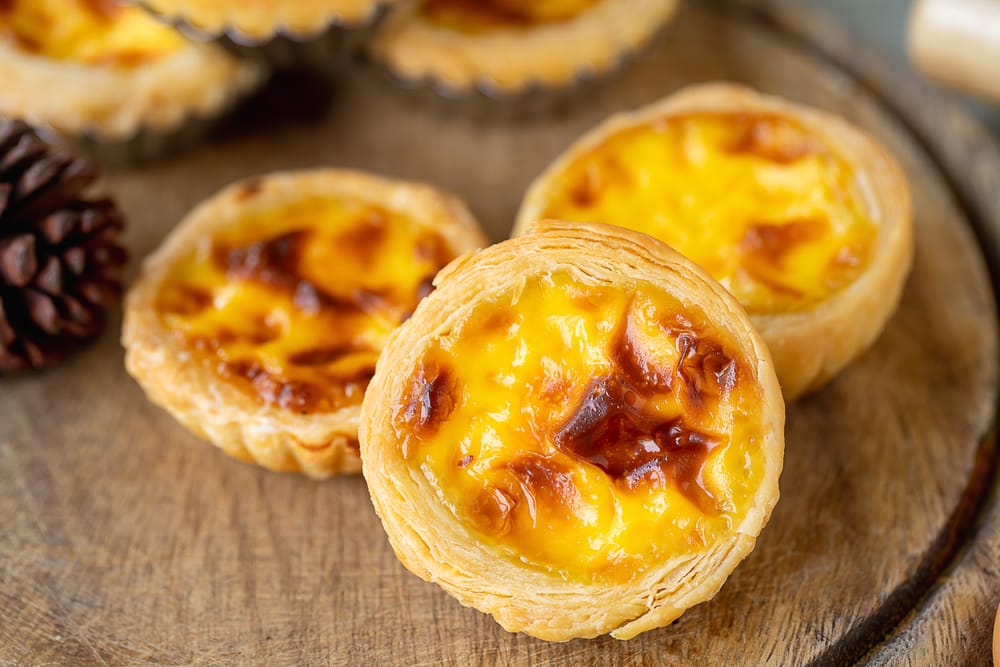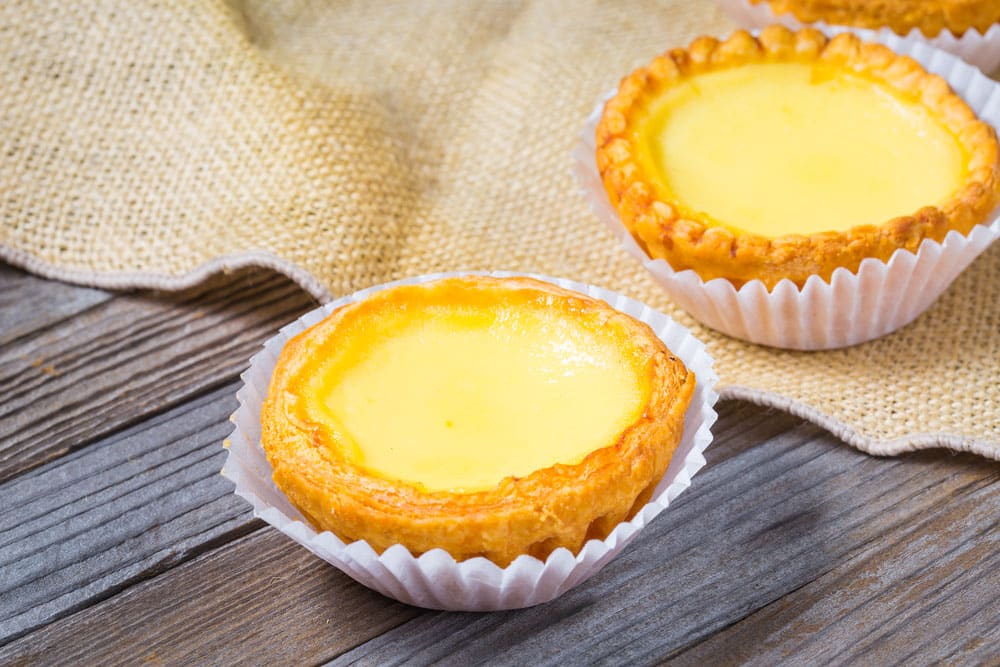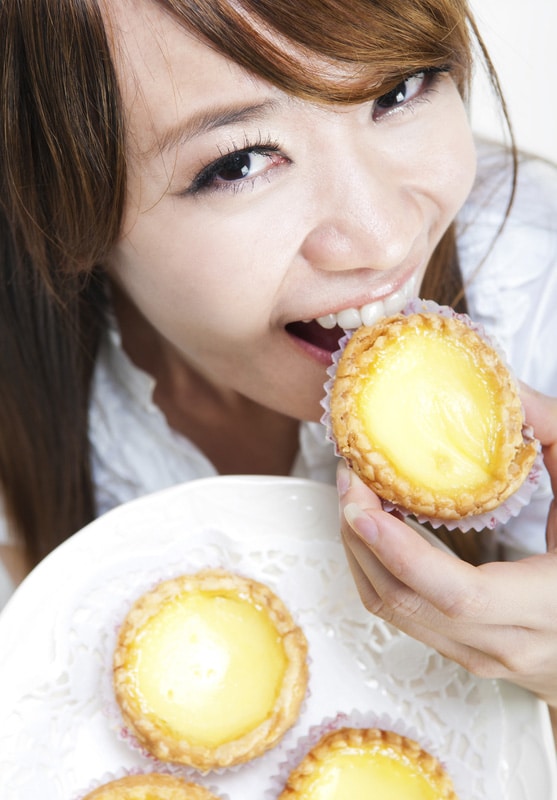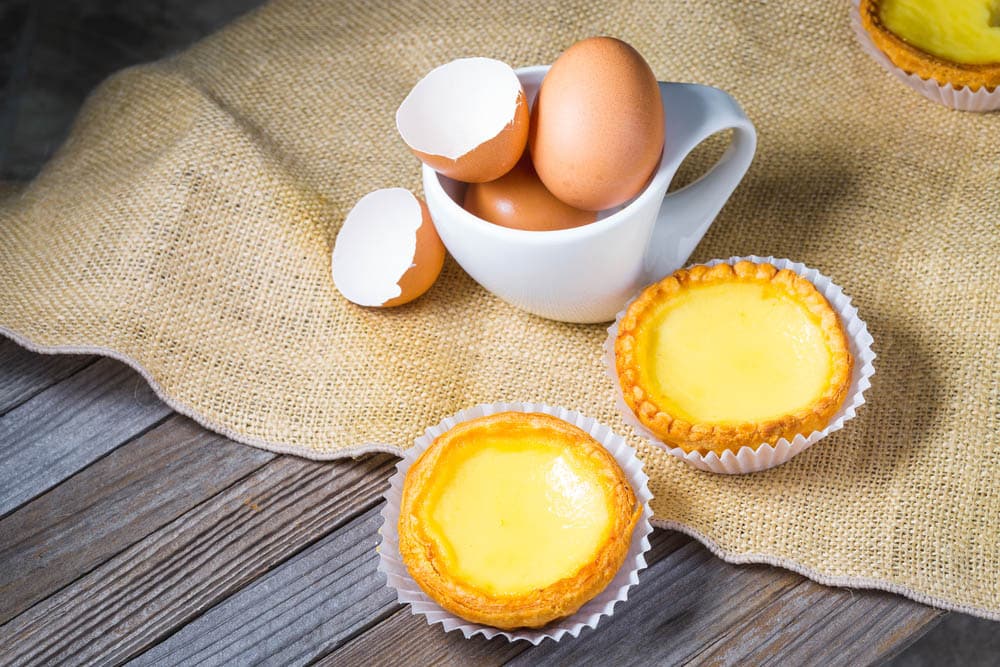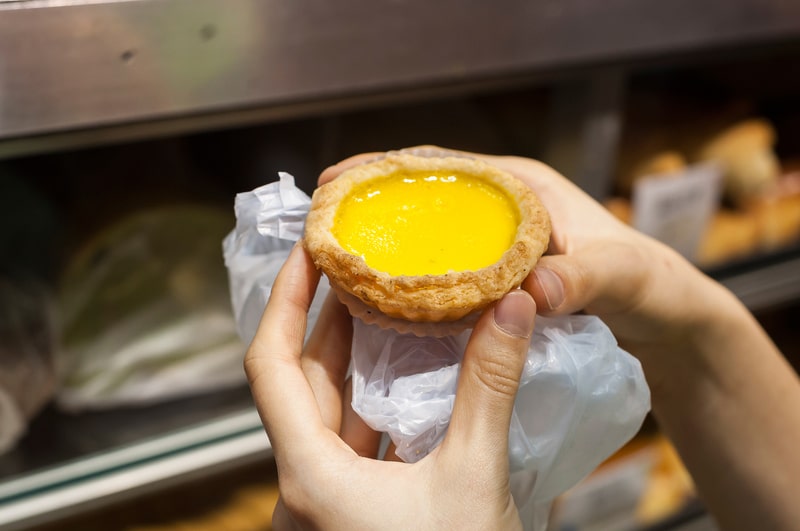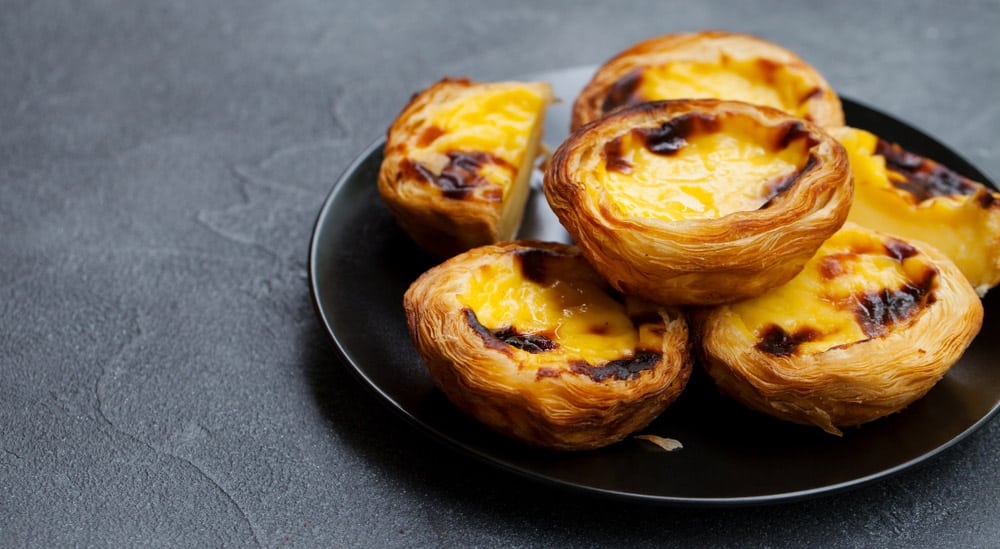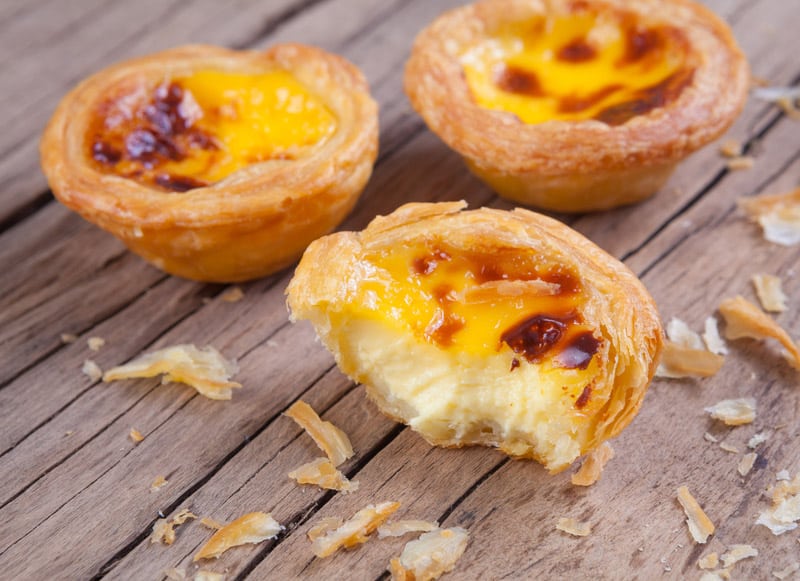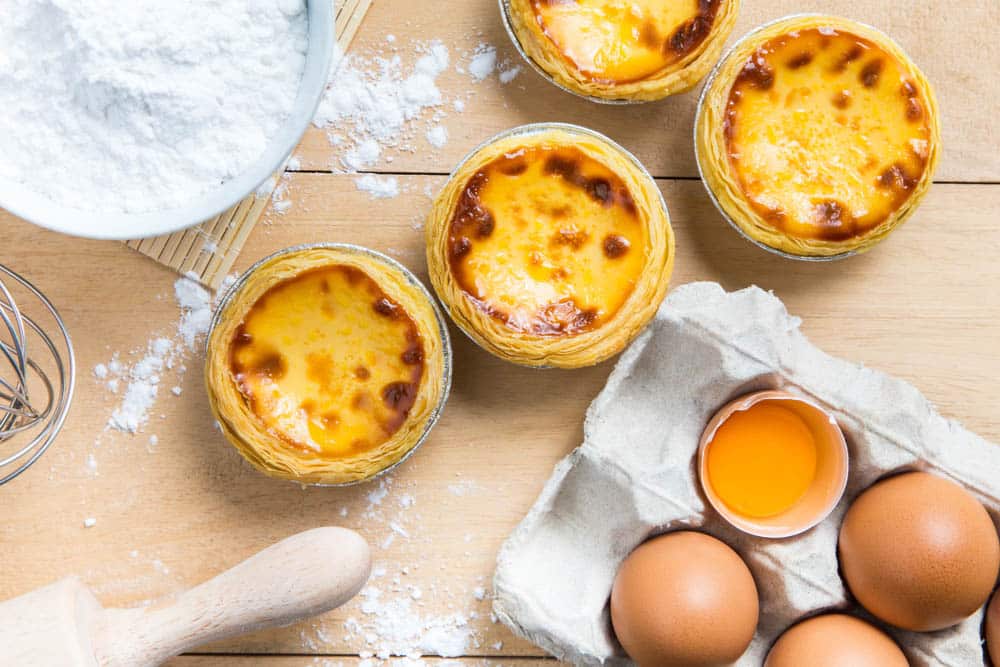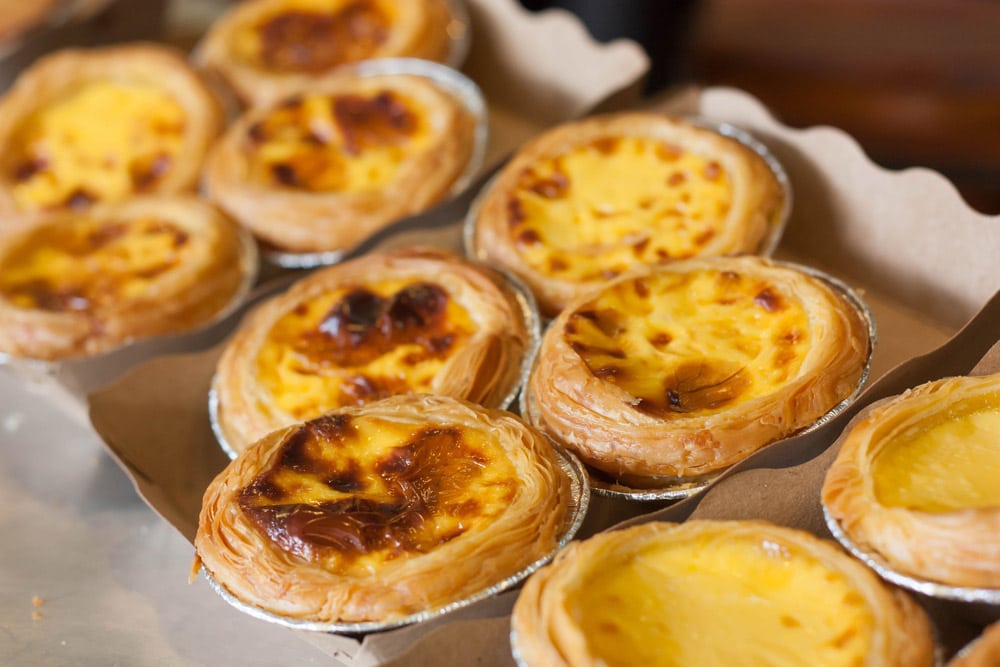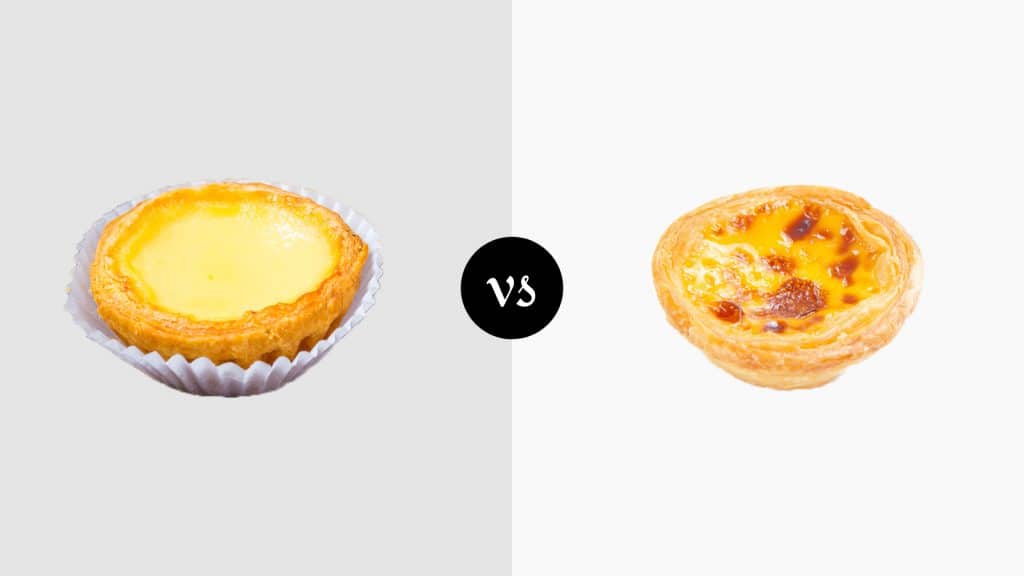
Egg tarts have become an ultimate dessert for people who want a rich and creamy option. This is because egg tarts are the just-right amount of sweet, and the overall texture is creamy yet delectably crispy at the same time.
The better option between Chinese egg tart vs Portuguese egg tart is a long-running debate. We are sharing all the details you need to know about them to make an informed decision over which you prefer.
Chinese Egg Tart vs Portuguese Egg Tart Comparison
| Chinese Egg Tart | Portuguese Egg Tart | |
|---|---|---|
| Names | Chinese Egg Tart, Daahn Tāat, Dàntǎ, Dan Tat, Macau Egg Tart, Po Tat | Portuguese Egg Tart, Pastéis de Nata, Pastel De nata, Pastel de Belém |
| Definition | Pastry Desert Inspired By Portuguese And English Egg Tarts, Featuring Shortcrust Or Chinese Puff Pastry Filled With Custard And Optional Flavor Additives | Portuguese Pastry Comprised Of Puff Pastry Shell Filled With Creamy Sweet Custard Then Baked Until Lightly Caramelized |
| Origin | Guangzhou - 1940s | Jerónimos Monastery in Belém in Western Lisbon - 1700+ |
| Flavor | Flaky Buttery Crust Filled With Creamy Sweet Custard Free From Milkiness | Hong Kong Egg Tarts Same But Sweeter | Macau Egg Tarts Have Bold Custard Flavor | Boldly Sweet But Milky Custard Flavor With Rich Caramelization |
| Cooking Difficulty | Relatively Easy | Original Recipe Trade Secret - High Difficulty |
| Ingredients | Flour, Butter, Sugar, Egg, Custard, Milk | Milk, Sugar, Water, Flour, Egg Yolks, Cinnamon Sticks, Lemon Peel, Custard Dough |
| Method | Water Based Dough & Oil Based Dough Combined To Create Chinese Puff Pastry - Tart Shells Made And Filled With Custard Created With Eggs And Extra Fine Sugar - Tarts Baked Until Just Done But Not Yet Browned | Boil Up Dense Sweet Custard By Combining Sugar Syrup With Cake Flour & Milk Cream Then Whisking In Egg Yolks - Fill Puff Pastry Tart Shells - Bake Until Caramelized |
| Serving Suggestion | Serve Two To Three At A Time Whilst Warm & Normally At Breakfast | Serve Fresh And Warm With Dusting Of Powdered Sugar And/Or Cinnamon |
Chinese Egg Tart vs Portuguese Egg Tart
As you’ll see in the upcoming comparison, there are distinct differences between Chinese egg tarts and Portuguese egg tarts. We’ve got everything that you need to know about the ins and outs of each tasty treat coming up.
Chinese Egg Tart
The Chinese egg tart is essentially a custard tart that has become an important part of Cantonese cuisine that’s actually derived from the original Portuguese variant.
Names
Chinese egg tart is most commonly referred to by its Jyutping name Daahn tāat. However, you’ll also find it called dàntǎ when spoken in Mandarin. English-speaking individuals often ask for Hong Kong-style tarts or “Dan Tat” when seeking Chinese egg tarts.
The Macau variation featuring a caramelized top is called ‘po tat,’ which is actually Cantonese for its Portuguese counterpart.
What Is Chinese Egg Tart?
A Chinese Egg Tart is a custard-based dessert that’s inspired by both English custard tarts and ever-popular Portuguese egg tarts.
While the basic recipe incorporates custard atop a Chinese puff pastry or shortcrust base, various variations featuring everything from green tea to chocolate and bird’s nest are available.
Origin
There are two primary variations of Chinese egg tart – egg tarts from Macau and Hong Kong. The very first Chinese egg tarts arose in the city of Guangzhou, situated on the banks of the Pearl River northwest of Hong Kong, during the 1940s.
Cha chaan tengs (local tea houses) began to feature the favored dessert across Hong Kong and its surrounding regions.
Macau-style Chinese egg tarts were made in 1989 in Lord Stow’s Bakery, situated on the island of Macau and owned by a British pharmacist Andrew Stow and his wife, Margaret Wong.
This variant had a special recipe, and it was sold to KFC in 1999, which was then introduced to and sold in Taiwan and Singapore. In addition, it is also famous in Indonesia since it’s largely regarded as the ultimate Portuguese enclave.
What Does Chinese Egg Tart Taste Like?
Chinese egg tarts have a flaky, buttery crust filled with creamy sweet piping hot custard that may or may not be flavored, depending on the recipe and variation in question.
Hong Kong-style egg tarts are typically sweeter than their Macau counterparts and come flavored, whereas Macau-style egg tarts have a more prominent custard flavor without any other additives.
Chinese Egg Tart Consistency
Expect a jelly-like consistency with a thin, crunchy pastry shell. Each tart will be firm but wobbly, and the crunch crumbles rather than being difficult to bite and excessively firm.
Cooking Difficulty
All egg tart recipes share a similar degree of difficulty, but the quintessential basis for all Portuguese egg tarts relies on a recipe that’s still a secret to this day. Considering this, Hong Kong egg tarts are easier to make than Portuguese egg tarts and Macau-style egg tarts.
Egg tarts cooked in the style that Macau is famous for requiring an exact degree of caramelization which can be tricky to perfect.
Chinese Egg Tart Ingredients
The basic ingredients for a Chinese egg tart are flour, butter, sugar, egg, custard, and milk. The pastry is typically shortcrust featuring lard, while Macau-style egg tarts most often utilize puff pastry.
Some chefs opt to add vanilla extract and a range of other flavor-changing ingredients. These include but are not limited to abalone, green tea, chocolate, cheese, pandan, and ube.
How Do You Make Chinese Egg Tarts?
Making Chinese egg tart starts with either making or buying the pastry. If you don’t have the time to make a batch of Chinese puff pastry, then either make or buy puff pastry or shortcrust dough.
Otherwise, two equal quantities of dough will need to be made. An oil-based dough is made by combining eight cups of cake flour, four cups of diced vegetable shortening, three sticks of butter, and one stick of margarine.
Once combined, roll out the dough to three-quarters of an inch thick, and then start your next dough. It is best to do this on parchment paper.
Water-based dough is made by combining seven and a half cups of cake flour with one cup of bread flour, two beaten eggs, one and a half to two cups of water, and half a cup each of ultra-fine sugar and diced white vegetable shortening.
Knead for ten minutes or until the dough becomes elastic, and then roll it out to the same thickness as the oil-based dough. Place both the water and oil dough into parchment-lined baking pans or a similar container and place them in the freezer for three hours.
After removing the two batches of dough from the freezer and allowing them to defrost for an hour or two to soften, roll the water-based dough out into a half-inch thick rectangle.
Cover this with the oil dough and roll it out while leaving a three-quarter-inch border of water dough around the entire perimeter. Cover the dual-layer with non-stick parchment paper and roll it out to a half-inch thick.
Remove the parchment and fold the left and right-hand sides of the rectangle toward the center evenly. Rotate and repeat the action with the other side, folding toward the middle. Depress and seal the edges before folding the two halves toward each other one last time.
Dust with flour and freeze for twenty minutes. Defrost and either fold into thirds by folding one side of the dough just over the center point and then folding the remaining section completely over the top and then freeze for another twenty minutes.
Use the pastry you made to lay out your tart shells and allow them to cool in the freezer for fifteen to twenty minutes while you make the filling. You’re aiming for roughly an eighth of an inch thick for the shells. Allow your oven to preheat to 350°F.
Create the filling by lightly beating six eggs. Whisk in three-quarters of a cup of ultra-fine sugar and two tablespoons of custard powder until the sugar dissolves completely. Stir in one and a half cups of evaporated milk.
Use a fine sieve to strain out any lumps, and then remove any bubbles that have formed using a spoon or ladle. Fill up your tart shells to just over two-thirds full (seventy percent) with the tart mixture.
Bake at 350°F for five minutes, then lower the temperature to 320°F and allow to bake for fifteen to twenty minutes or until the custard sets. Turn off the oven but leave the egg tarts inside for another minute before removing and allowing them to cool slightly before serving.
Serving Suggestion
Hong-Kong style Chinese egg tarts are famous for their small size, and two to three are served at one time. Chinese egg tarts are generally consumed as a breakfast pastry.
Portuguese Egg Tart
One can’t forget that Portuguese egg tarts from its homeland Lisbon have become named one of the 50 best things to consume around the globe.
They’re a classic that everyone needs to try at some point, even if homemade instead of direct from the bakery that bought the original recipe.
Names
The Portuguese name for Portuguese Custard Tarts is Pastéis de Nata which translates to Pastel de nata in English.
The variety that gained popularity in China was Pastel de Belém which translates to Pastries of Bethlehem (which is a reference to Saint Mary of Bethlehem parish in Lisbon, where the recipe originated).
What Is Portuguese Egg Tart?
Portuguese egg tart is commonly known as pasteis de nata and is known for its denser texture as compared to a Chinese egg tart. Each tart is made up of a puff pastry shell filled with a dense, creamy custard that’s been baked until lightly caramelized.
Origin
Pastel de nata was invented by monks in service at the Jerónimos Monastery in Belém in Western Lisbon. While the precise date remains unknown, historians place its origin some time ahead of 1700 but before the turn of the 18th century.
The bustling parish would often resort to using egg whites to starch their closing due to not having enough detergent. This left an abundance of egg yolks which were soon honed into a top-secret recipe for custard tarts that supplied a steady income to the monastery.
In 1834, the monastery closed down, and the monks sold their recipe to Fábrica de Pastéis de Belém, which officially opened its doors in 1837 in Lisbon.
Today, the old monastery is a UNESCO World Heritage Site and Fábrica de Pastéis de Belém situated a short walk from the monastery still sells Pastéis de Belém.
What Does Portuguese Egg Tart Taste Like?
Expect a sweeter, milkier custard taste than Chinese egg tarts overall, with caramelization and a consistency that’s often compared to creme brulee. In the majority of cases, it is dusted with cinnamon which adds a unique flavor.
Classic Portuguese egg tarts have been influenced by Japanese cuisine. Japanese people tend to love to add green tea flavoring to enhance and modify the overall taste making this a commonly encountered variation.
Portuguese Egg Tart Consistency
For the most part, Portuguese egg tarts tend to be milkier and have a pudding-like texture in the center.
Many people also associate its top with crème Brulee, so it’s best that you keep such consistency in mind if making your own at home. This pastry also has a thick and much drier crust which differentiates it from Chinese egg tarts.
Cooking Difficulty
The key to perfectly baked Pasteis de Nata is an oven that reaches an ultra-high 500°F which unfortunately means that most home bakers won’t be able to get the caramelization and crispy crust that these tasty classic pastries call for.
Also, while several good recipes are available, the exact recipe for authentic Portuguese egg tarts is a closely guarded secret that is only held by descendants of monks of the Jerónimos Monastery in Belém, the wonders, and the staff of Fábrica de Pastéis de Belém. They’re very difficult to perfect.
Portuguese Egg Tart Ingredients
Pastel de nata includes milk, sugar, water, flour, egg yolks, cinnamon sticks, lemon peel, custard dough, and optionally, cinnamon powder and/or powdered sugar.
How Do You Make Portuguese Egg Tarts?
Bring one-third of a cup of water to the boil in which two-thirds of a cup of refined white sugar has been dissolved. Stir in the sugar before bringing the mixture to a boil, and don’t stir it once boiling.
Stop once it reaches the point where you can drop a droplet into cold water and watch it immediately form a pearl. Mix three tablespoons of cake flour with an equal quantity of milk taken from a measured cup and stir until a smooth cream-like paste is reached.
Add the remaining milk to a new pot. Toss in one to two cinnamon sticks and three or four lemon peels, and then bring the pot to a boil. Remove from the heat. Whisk in the flour mixture you made earlier and continue whisking until a dense consistency is reached.
Combine the sugar solution you mixed on at the beginning with the milk and flour cream you just whisked up. Whisk until well combined. There should be no lumps at all. Add a tablespoon or two of this cream to your egg yolks and still well.
Slowly stir in the egg yolk mixture into your pot of cream, and then remove both the cinnamon sticks and lemon peel. Roll out the dough to 3/4-inch thick and then cut out discs and form tarts within a lined or greased muffin tray.
Once the tart shells are formed, let each tray cool in the fridge for ten minutes before dispensing the cream. Fill each tart to three-quarter full and then bake in an oven preheated to 475°F for ten to twelve minutes or until the top begins to caramelize and brown.
You generally want to bake these at the highest temperature your oven goes. You’ll have two trays of pasteis de nata ready to go.
Serving Suggestion
The best way to eat Portuguese egg tarts with a dusting of either powdered sugar or powdered cinnamon or both. It is always best to eat these tasty pastries while they’re still warm and the pastry shell is crispy.
What Is The Difference Between Chinese Egg Tart And Portuguese Egg Tart?
The main difference between Chinese egg tarts and Portuguese egg tarts is that Chinese egg tarts typically use a shortcrust pastry or Chinese puff pastry and feature a smooth filling without caramelization, whereas sweeter Portuguese egg tarts are made using puff pastry and have a crumbly, flaky crust and a visible degree of browning that grants distinct toasty flavor and a puffed-up appearance.
Which Is Best, Chinese Egg Tart vs Portuguese Egg Tart?
Picking a winner between a Chinese egg tart vs Portuguese egg tart largely depends on your preference for sweetness, milky flavor, and the texture preferred.
Anyone who doesn’t like the flavor of dairy featuring in their tart prominently will prefer Chinese egg tarts, which also have a silkier texture. That said, Portuguese egg tarts are sweeter and come caramelized, adding a distinct flavor note. Ultimately, it’s up to you.
